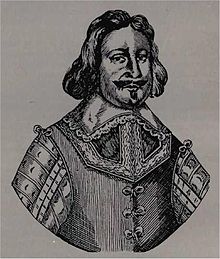Ferdinando Fairfax, 2nd Lord Fairfax of Cameron

Ferdinando Fairfax, 2nd Lord Fairfax of Cameron (29 March 1584–14 March 1648), English parliamentary general, was a son of Thomas Fairfax, whom Charles I in 1627 created Lord Fairfax of Cameron in the Peerage of Scotland.
Born in Yorkshire, Ferdinando Fairfax obtained his military education in the Netherlands, and served as member of the English parliament for Boroughbridge during the six parliaments which met between 1614 and 1629 and also during the Short Parliament of 1640. In May 1640 he succeeded his father as Lord Fairfax, but being a Scottish peer he sat in the English House of Commons as one of the representatives of Yorkshire during the Long Parliament from 1640 until his death; he took the side of the parliament, but held moderate views and desired to maintain the peace. His main seat was Denton Hall in Wharfedale.
In the first Scottish war Fairfax had commanded a regiment in the king's army; then on the outbreak of the Civil War in 1642 he became commander of the parliamentary forces in Yorkshire, with Newcastle as his opponent. Hostilities began after the repudiation of a treaty of neutrality entered into by Fairfax with the Royalists.
At first Fairfax met with no success. He was driven from York, where he was besieging the Royalists, to Selby; then in 1643 to Leeds; and after beating off an attack at that place he was totally defeated on 30 June 1643 at the Battle of Adwalton Moor. He escaped to Hull, which he successfully defended against Newcastle from 2 September until 11 October 1643, and by means of a brilliant sally caused the siege to be raised.
Fairfax was victorious at Selby on 11 April 1644, and joining the Scots, besieged York, after which he was present at the Battle of Marston Moor (2 July 1644), where he commanded the infantry and was routed. He was subsequently, in July 1644, made Governor of York and charged with the further reduction of the county. In December 1644 he took the town of Pontefract, but failed to secure the castle.
Fairfax resigned his command on the passing of the Self-denying Ordinance, but remained a member of the Committee for the Government of Yorkshire, and was appointed, on 24 July 1645, steward of the manor of Pontefract. He died from an accident on 14 March 1648 and was buried at Bolton Percy in Yorkshire.
Fairfax married twice. By his first wife, Mary, daughter of Edmund Sheffield, 3rd Lord Sheffield (afterwards 1st earl of Mulgrave), he had six daughters and two sons: Thomas, who succeeded him as 3rd lord, and Charles, a colonel of horse, who was killed at Marston Moor. He also fathered translator Edward Fairfax outside of wedlock.
During his command in Yorkshire, Fairfax engaged in a paper war with Newcastle, and wrote The Answer of Ferdinando, Lord Fairfax, to a Declaration of William, Earl of Newcastle (1642; printed in Rushworth, pt. iii. vol. ii. p. 139); he also published A Letter from . . . Lord Fairfax to . . . Robert, Earl of Essex (1643), describing the victorious sally at Hull.
References
- This article incorporates text from a publication now in the public domain: Chisholm, Hugh, ed. (1911). Encyclopædia Britannica (11th ed.). Cambridge University Press.
{{cite encyclopedia}}: Missing or empty|title=(help)
